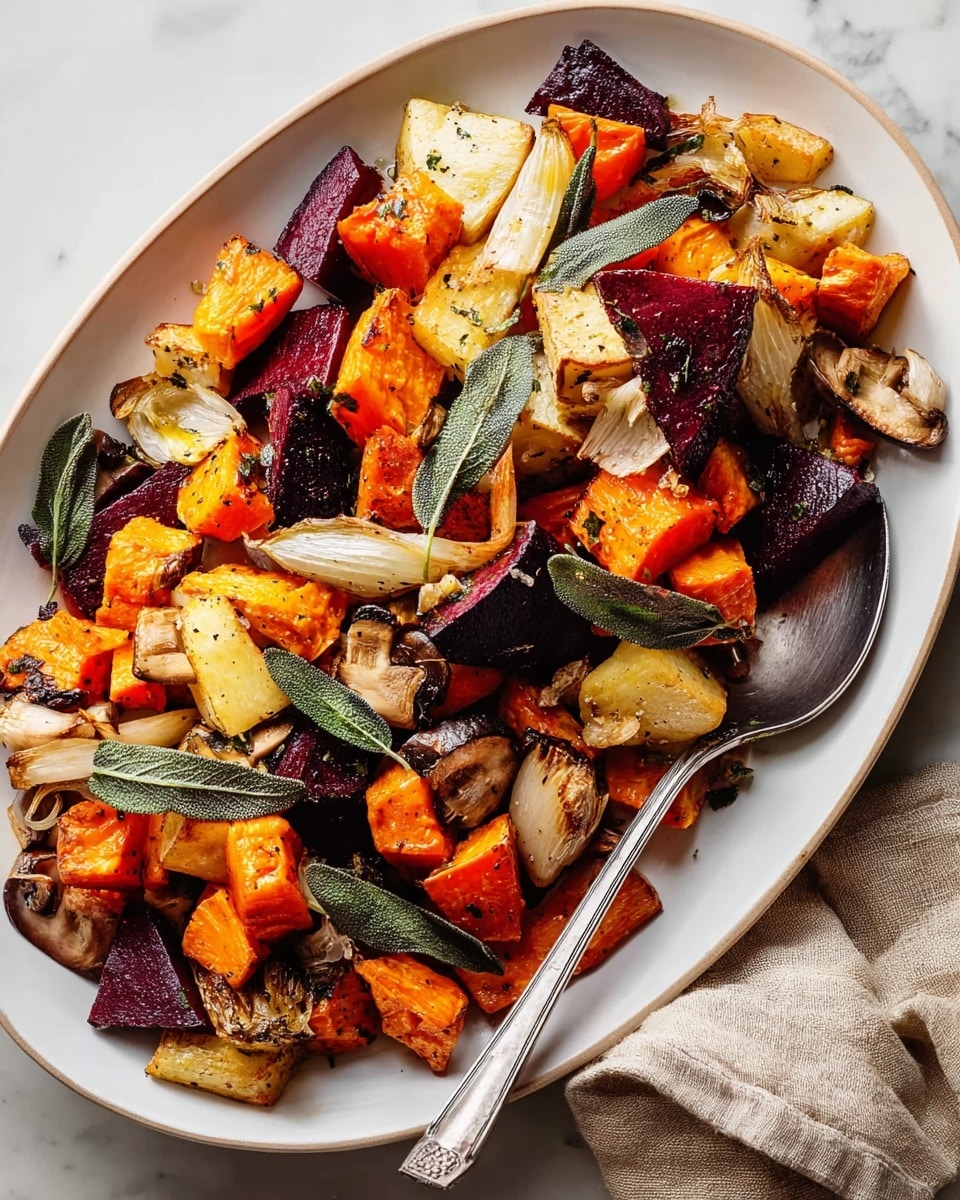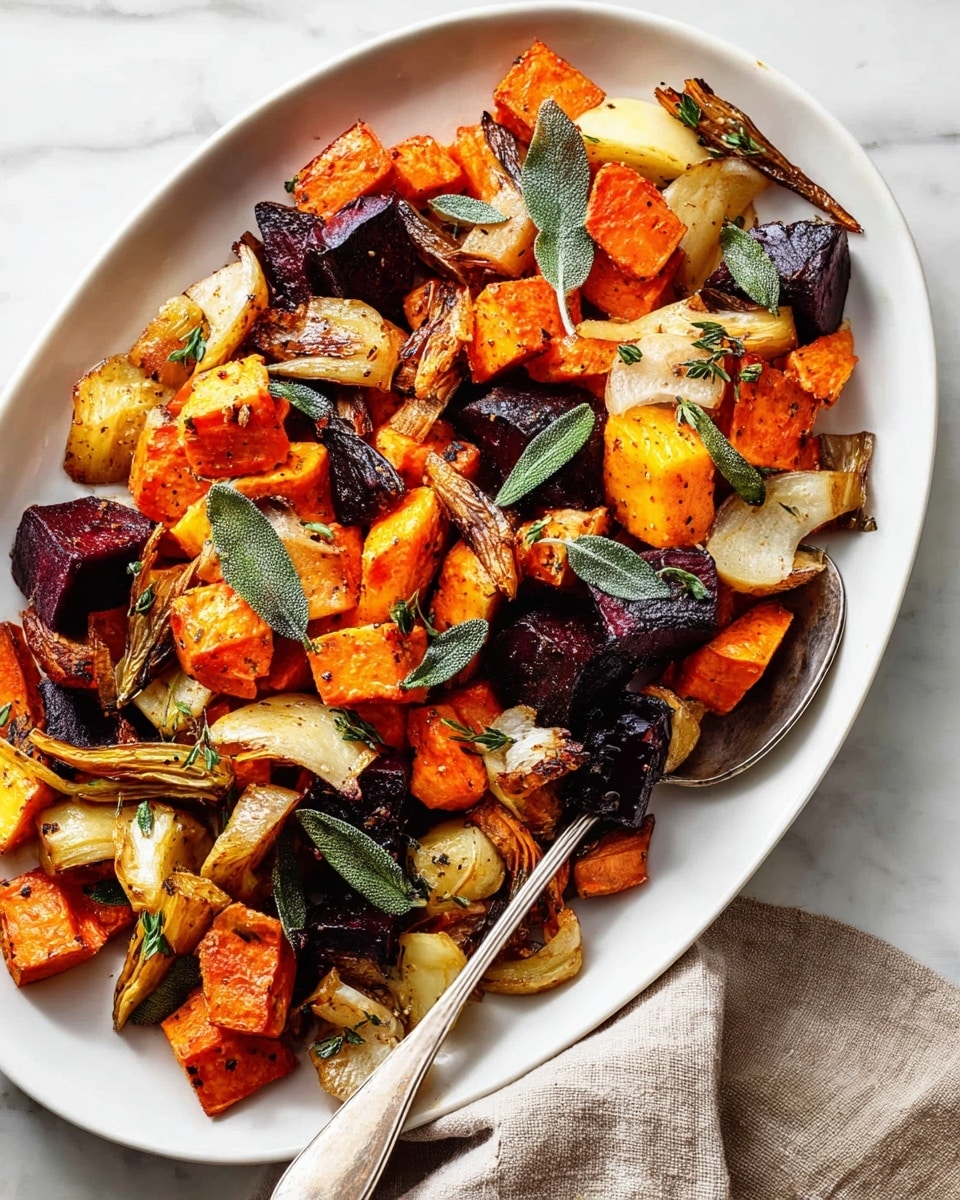If you’re looking for a cozy, flavorful side dish that truly elevates humble vegetables, you have to try my Roasted Root Vegetables with Sage Oil and Crispy Sage Leaves Recipe. This dish brings together the natural sweetness of roasted roots and the aromatic punch of sage in two delightful textures — silky oil and crispy leaves. When I first tried this, I was hooked by how those crispy sage leaves contrasted perfectly with soft, caramelized veggies. Trust me, stick with me here and you’ll be making this your go-to side for fall, winter, and beyond!
Why You’ll Love This Recipe
- Comforting and Seasonal: This recipe capitalizes on hearty root vegetables that shine in cooler months and bring warmth to your table.
- Simple Yet Gourmet: The addition of sage oil and crispy sage leaves transforms basic roasted veggies into a sophisticated side worth bragging about.
- Easy to Customize: You can swap out root veggies or herbs based on what you have, making it super adaptable.
- Perfect for Any Occasion: Whether it’s a holiday feast or weeknight dinner, this dish effortlessly elevates your meal.
Ingredients You’ll Need
What makes this Roasted Root Vegetables with Sage Oil and Crispy Sage Leaves Recipe so delicious is the blend of diverse root veggies paired with fresh herbs. Choosing fresh sage and rosemary really makes the flavors pop, so be sure to grab good-quality herbs and fresh produce.
- Beets: I like using one red and one golden for color contrast and slightly different sweetness.
- Carrot: Roll cut into chunks keeps them roasting evenly without falling apart.
- Parsnips: Their nutty flavor adds depth to the veggie mix.
- Sweet potato: Adds a creamy, sweet balance against earthier roots.
- Turnip: Slightly peppery bite that gives the overall dish a nice edge.
- Extra-virgin olive oil: For roasting and making the sage oil; quality oil really enhances the flavors.
- Fresh rosemary: Woody aroma complements the root vegetables perfectly.
- Fresh sage leaves: Used both chopped in the veggies and whole for the crispy garnish.
- Fresh thyme leaves: Adds subtle earthiness and freshness.
- Sea salt and freshly ground black pepper: To season and bring all the flavors together.
Variations
I’ve played around with this recipe quite a bit and love how versatile it is. Depending on what’s in season—or what’s lingering in my fridge—I tweak the vegetables and herbs to keep it fresh and exciting.
- Root swaps: Tried using rutabagas or sweet potatoes instead of turnip and loved the slightly sweeter result.
- Herb adjustments: Rosemary and thyme can be swapped with tarragon or oregano if you want a different herbaceous vibe.
- Make it spicy: Adding a pinch of smoked paprika or cayenne pepper before roasting gives a subtle kick that my family goes crazy for.
- Vegan and gluten-free: Perfect as-is, just be sure your sage oil is made with pure olive oil!
How to Make Roasted Root Vegetables with Sage Oil and Crispy Sage Leaves Recipe
Step 1: Prep and Separate for Perfect Roasting
Start by preheating your oven to a toasty 425°F and lining two baking sheets with parchment paper. The trick I learned? Because beets and carrots take longer to roast than parsnips, sweet potatoes, and turnips, place them on separate sheets so you can control timing better — trust me, this keeps everything from getting mushy or burnt.
Step 2: Season and Toss with Fresh Herbs
Drizzle the veggies generously with extra-virgin olive oil, then sprinkle chopped rosemary, sage, thyme, salt, and pepper. Toss each baking sheet well to ensure every chunk is coated in that herby goodness. I often use my hands here — it’s messy but effective!
Step 3: Roast to Caramelized Perfection
Roast your vegetables, knowing that parsnips, sweet potato, and turnip will take roughly 25 minutes, while beets and carrots need closer to 50. I like to check them every 10-15 minutes and give things a gentle toss to ensure even caramelization.
Step 4: Make the Magical Sage Oil and Crispy Leaves
This is the step that sends the whole dish over the top. Heat olive oil in a small saucepan until it’s shimmering and bubbling — then quickly add your fresh sage leaves. Stir gently for about a minute until they turn crisp but don’t burn. Remove them with tongs onto paper towels to drain. Keep the fragrant sage oil left in the pan to drizzle over your veggies later.
Step 5: Toss, Transfer, and Garnish
Once your root vegetables are tender and beautifully browned, remove them from the oven. Toss them with a tablespoon of that reserved sage oil — it really amplifies the flavor. Transfer everything to a large serving platter and scatter the crispy sage leaves on top. Right then, you’ll see why this Roasted Root Vegetables with Sage Oil and Crispy Sage Leaves Recipe is such a gem!
Pro Tips for Making Roasted Root Vegetables with Sage Oil and Crispy Sage Leaves Recipe
- Evenly Sized Chunks: Cutting your veggies into uniform 1-inch pieces helps them roast evenly — no surprises with some floppy bits or raw centers.
- Separate Baking Sheets: I learned that roasting beets and carrots separately prevents overcooking the more delicate sweet potato and parsnips.
- Don’t Overcrowd the Pan: Give your veggies room to roast rather than steam — spread them out so they get that beautiful caramelized edge.
- Watch the Sage Leaves: They crisp incredibly fast — one minute is usually enough, or they’ll turn bitter. Keep an eye on the oil bubbling and immediately remove when crispy.
How to Serve Roasted Root Vegetables with Sage Oil and Crispy Sage Leaves Recipe

Garnishes
I love sprinkling a little flaky sea salt right before serving to boost textures and flavor. Sometimes, I add a drizzle of good balsamic vinegar or a squeeze of lemon juice for brightness. Freshly grated Parmesan is a delightful option if you’re not keeping this vegan.
Side Dishes
This recipe pairs incredibly well with roasted or grilled meats like chicken or pork, but I’ve also served it alongside quinoa or creamy polenta for a vegetarian feast. The rustic flavors complement so many mains—it’s a real crowd pleaser.
Creative Ways to Present
For holiday dinners, I’ve served these roasted root vegetables in a rustic wooden bowl topped with whole crispy sage leaves as a centerpiece side dish. Another fun idea is layering them over a white platter and garnishing with edible flowers or microgreens for a fresh pop of color.
Make Ahead and Storage
Storing Leftovers
I store leftover roasted vegetables in an airtight container in the fridge for up to 3 days. The crispy sage leaves lose some crunch, so I usually keep them separate and add fresh crispy sage before serving again.
Freezing
Root veggies freeze pretty well, but the texture shifts a bit on thawing. I freeze only the roasted vegetables (without crispy sage) in a freezer-safe bag and use them later in soups or stews where texture isn’t as critical.
Reheating
To bring leftover roasted roots back to life, I reheat them in a hot oven or toaster oven at 375°F for about 10 minutes to revive some caramelization. Avoid microwaving if you want to keep them from getting soggy. Add fresh crispy sage leaves on top just before serving.
FAQs
-
Can I use dried sage instead of fresh for the sage oil and crispy leaves?
Dried sage doesn’t crisp up the same way fresh leaves do and can taste more bitter when fried. For the best sage oil and crispy leaf texture, I really recommend using fresh sage leaves for this recipe.
-
How do I know when the roasted root vegetables are done?
Look for tender roots when pierced with a fork and nice caramelized edges. The parsnips and sweet potatoes will be done around 25 minutes, while beets and carrots require closer to 45-50 minutes. Testing early is key, as ovens vary.
-
Can I prepare this recipe ahead of time?
Yes! You can chop and season the veggies ahead and keep them chilled until ready to roast. The crispy sage leaves are best made fresh just before serving to keep their crunch.
-
Is this recipe suitable for a vegan diet?
Absolutely. This dish uses no animal products and relies on olive oil and fresh herbs for flavor. Just make sure any additional garnishes, like cheese, are omitted or replaced with vegan alternatives.
Final Thoughts
I absolutely love how this Roasted Root Vegetables with Sage Oil and Crispy Sage Leaves Recipe turns out every time. It’s one of those dishes that feels fancy but is so easy to make, perfect for both weekday dinners and special holidays. I know once you try roasting these veggies alongside the fragrant sage oil and crunchy leaves, you’ll be hooked just like my family and me. Give it a go and watch how it transforms even the simplest meal into something truly memorable!
Print
Roasted Root Vegetables with Sage Oil and Crispy Sage Leaves Recipe
- Prep Time: 15 minutes
- Cook Time: 45 minutes
- Total Time: 60 minutes
- Yield: 4 to 6 servings 1x
- Category: Side Dish
- Method: Roasting
- Cuisine: American
- Diet: Vegan
Description
This Roasted Root Vegetables recipe features a colorful medley of beets, carrots, parsnips, sweet potatoes, and turnips, roasted to tender perfection with fresh herbs. Enhanced by a drizzle of fragrant sage oil and topped with crispy sage leaves, this dish offers a rich, earthy flavor perfect as a comforting side for any fall or winter meal. Vegan, gluten-free, and easy to prepare, it’s ideal for holidays or everyday dining.
Ingredients
Vegetables
- 2 beets, preferably 1 red and 1 golden (peeled and chopped into 1-inch chunks)
- 1 large carrot (roll cut into 1-inch chunks)
- 3 parsnips (chopped into 1-inch chunks)
- 1 medium sweet potato (chopped into 1-inch chunks)
- 1 turnip (chopped into 1-inch chunks)
Herbs & Seasoning
- 1 tablespoon chopped fresh rosemary
- 1 tablespoon chopped fresh sage leaves
- 1 tablespoon fresh thyme leaves
- Sea salt and freshly ground black pepper, to taste
Oils
- Extra-virgin olive oil, for drizzling and cooking (about 3 tablespoons total)
Garnish
- 10 fresh sage leaves
Instructions
- Preheat Oven: Preheat the oven to 425°F (220°C) and line two baking sheets with parchment paper to prevent sticking and facilitate even roasting.
- Prepare Vegetables: Place the beets and carrots on one baking sheet, and the parsnips, sweet potato, and turnip on the other. Drizzle all vegetables with extra-virgin olive oil. Sprinkle chopped rosemary, sage, thyme, sea salt, and freshly ground black pepper over them. Toss each baking sheet’s contents to coat evenly and spread the vegetables in a single layer.
- Roast Vegetables: Roast in the preheated oven for 25 to 50 minutes. The parsnips, sweet potato, and turnip will cook faster, usually needing 25-30 minutes, while beets and carrots require longer, closer to 45-50 minutes. Roast until the vegetables are tender and caramelized around the edges, stirring once or twice for even cooking.
- Make Crispy Sage: While vegetables roast, line a plate with paper towels. Heat about 2 tablespoons of olive oil in a small saucepan over medium heat until it bubbles gently. Add fresh sage leaves, stirring gently and cooking for about 1 minute or until they become crisp. Remove the sage leaves with a slotted spoon and transfer to the paper towel-lined plate to drain excess oil. Reserve the sage-infused oil for dressing the vegetables.
- Toss and Serve: Once vegetables are roasted, remove them from the oven and transfer to a serving platter. Drizzle with 1 tablespoon of the reserved sage oil and toss gently to coat. Finish by topping the vegetables with the crispy sage leaves for an aromatic and textural contrast. Serve warm as a delicious side dish.
Notes
- These roasted root vegetables make a wonderful, nutritious side dish that pairs well with many main courses, especially in fall and winter.
- Using a mixture of red and golden beets adds beautiful color variety.
- The sage oil and crispy sage leaves add a rich, earthy flavor that elevates the dish.
- For optimal roasting, try to cut all vegetables into similar-sized chunks for even cooking.
- This recipe is vegan and gluten-free.
- Leftovers can be stored in an airtight container in the refrigerator for up to 3 days and reheated gently in the oven.
Nutrition
- Serving Size: 1 cup (about 150g)
- Calories: 110
- Sugar: 7g
- Sodium: 120mg
- Fat: 5g
- Saturated Fat: 0.7g
- Unsaturated Fat: 3.5g
- Trans Fat: 0g
- Carbohydrates: 16g
- Fiber: 4g
- Protein: 2g
- Cholesterol: 0mg



